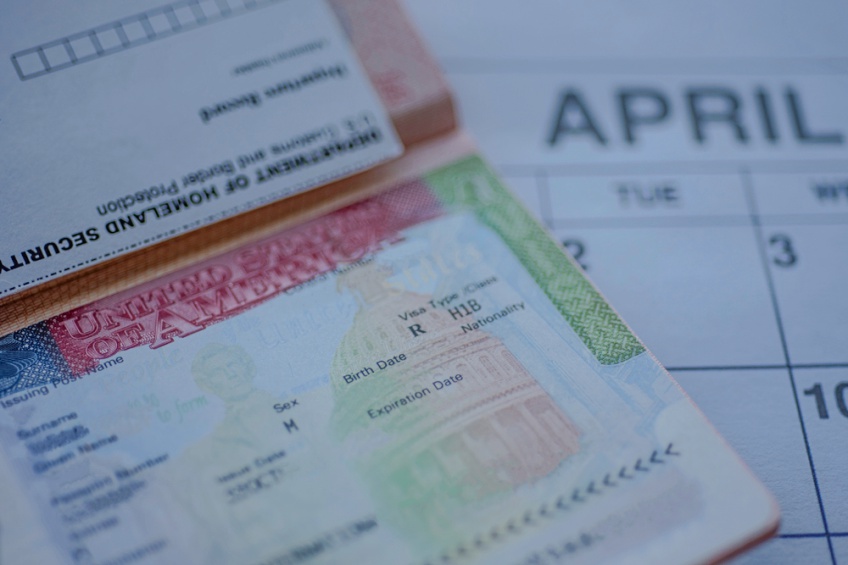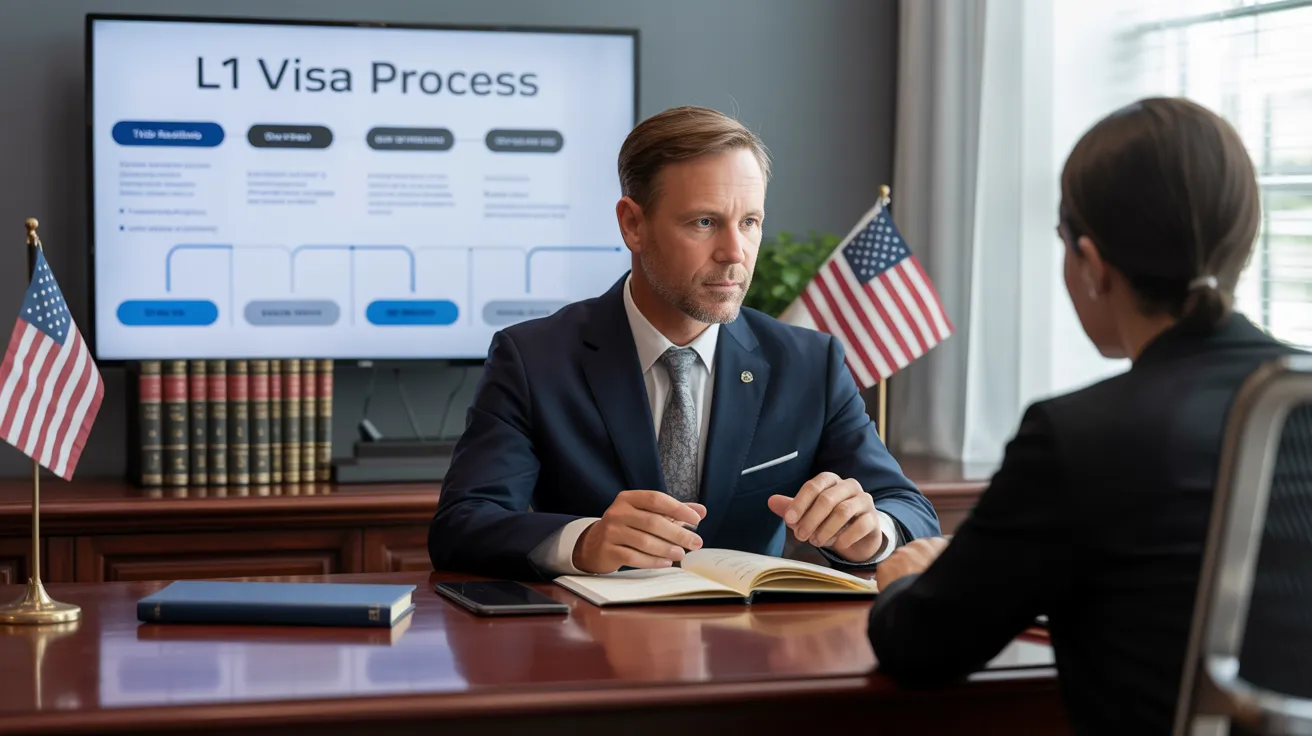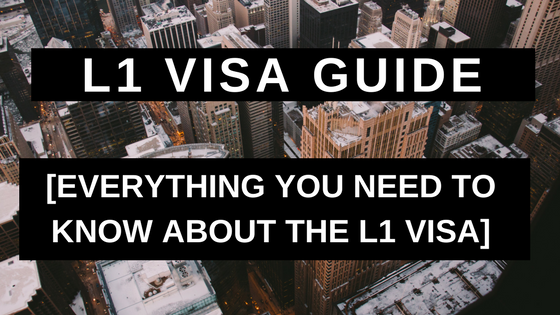Opening Opportunities: A Comprehensive Overview to the L1 Visa Process
The L1 visa procedure offers a vital pathway for multinational companies seeking to transfer crucial employees across boundaries. Comprehending the nuances of qualification requirements, the distinctions between L-1A and L-1B visas, and the ins and outs of the application process can greatly impact a candidate's success. However, navigating this complicated landscape is not without its obstacles, and mindful focus to documentation and company sponsorship is important. As we check out the vital components of this process, the techniques for getting over prospective obstacles will certainly become noticeable, exposing exactly how informed preparation can open up a globe of opportunities.
Recognizing the L1 Visa
Comprehending the L1 visa requires recognizing its value as a vital device for multinational firms looking for to transfer competent employees between global offices. This non-immigrant visa classification helps with the motion of execs, managers, and specialized expertise workers to the United States, therefore enabling companies to preserve operational connection and harness international skill successfully. The L1 visa is split into 2 key classifications: L-1A for supervisors and executives, and L-1B for employees having specialized knowledge.The L1 visa offers a vital role in improving a business's one-upmanship in the worldwide industry - L1 Visa Requirements. By allowing firms to transfer their key workers, organizations can assure that vital jobs are taken care of by qualified individuals that are currently acquainted with the company's culture and operational processes. This internal transfer device not only promotes knowledge sharing however additionally promotes advancement and cooperation across borders.Moreover, the L1 visa is usually favored for its relatively uncomplicated application process compared to other visa classifications, as it enables double intent, allowing holders to go after long-term residency while on a momentary job visa. This attribute makes the L1 visa specifically appealing for both companies and employees, as it enhances the pathway for skilled specialists to develop lasting residency in the United States
Eligibility Requirements
Eligibility for the L1 visa depends upon several essential criteria that assure both the employee and the company fulfill specific certifications. This non-immigrant visa is designed for multinational business to move workers from consular services to U.S. counterparts.Firstly, the employer has to be a qualifying company, which consists of a parent business, branch, affiliate, or subsidiary of an U.S. service. The business needs to have been doing company for at the very least one year both in the united state and abroad. This ensures that the business has sufficient operational security and a reputable presence.Secondly, the staff member has to hold a supervisory, executive, or specialized understanding setting. For L1A visas, the applicant should demonstrate supervisory or executive certifications, while L1B visas concentrate on specialized understanding relevant to the organization's items, services, or procedures. In addition, the worker must have functioned for the international entity for a minimum of one continuous year within the last three years prior to their application.Lastly, the worker's role in the united state must line up with their previous position, guaranteeing that their abilities and competence are leveraged for the business's advantage.
Kinds Of L1 Visas
The L1 visa classification comprises 2 main types created to facilitate the transfer of workers within multinational firms: the L1A visa for managers and execs, and the L1B visa for staff members with specialized expertise. Each type offers unique objectives and has details qualification criteria.The L1A visa is customized for individuals that hold supervisory or executive settings within a business. This visa makes it possible for high-level staff members to transfer to a united state branch, subsidiary, or associate of the exact same organization. Candidates for the L1A visa need to show that they have been utilized in a managerial or executive ability for at the very least one continual year within the past three years before their application. Additionally, this visa provides a much longer period of stay, originally given for 3 years, with the opportunity of expansions for up to seven years.In comparison, the L1B visa is meant for experts with specialized expertise relevant to the business's items, services, or processes. To certify, candidates have to show that their competence is critical to the organization and that they have actually helped at the very least one continuous year within the last three years in a duty that required this specialized knowledge. The L1B visa is originally provided for 3 years, with expansions offered for approximately 5 years.Both visa kinds are crucial for companies seeking to improve their global procedures by leveraging skilled workers, thus promoting advancement and performance within the united state market.
Application Process
Steering through the L1 copyright process includes a number of important steps that should be diligently complied with to ensure a successful end result. The procedure starts with the united state employer, that must initially develop qualification by demonstrating a qualifying relationship with the international entity and confirming that the staff member meets the particular demands for the L1 visa group being sought.Once eligibility is confirmed, the company launches the procedure by submitting Form I-129, the Request for a Nonimmigrant Employee, with the United State Citizenship and Migration Solutions (USCIS) This type should be gone along with by an in-depth summary of the job responsibilities to be performed, the business framework of both the U.S. and foreign entities, and the staff member's certifications. It's important to confirm that all info is accurate and full, as noninclusions or inaccuracies can result in delays or denials.Upon authorization of the I-129 request, the following step includes the worker applying for the L1 visa at a united state consular office or consular office in their home country. This phase needs the conclusion of Kind DS-160, the Online Nonimmigrant copyright, and setting up an interview. Throughout the meeting, the candidate must provide proof sustaining their credentials and the employer's petition.After the visa is provided, the worker can get in the United States to operate in the designated role. Overall, mindful preparation and adherence to every step of the application process are essential for a successful L1 visa result.
Needed Documentation

Important Kinds Needed
Steering the L1 Visa process calls for careful attention to the essential types and paperwork necessary for a successful application. The key type needed is the Kind I-129, Request for a Nonimmigrant Worker, which must be completed and submitted by the united state company. This type outlines the details of the work offer and the certifications of the staff member seeking the L1 Visa.Alongside Type I-129, the candidate will require to complete Type I-539 if coming with relative are likewise getting visas. Furthermore, the company needs to give proof of the qualifying partnership between the U.S. entity and the foreign entity, typically requiring the submission of corporate documents such as short articles of unification or economic statements.Moreover, it is vital to include the L Category Supplement to Kind I-129, which defines the type of L Visa being requested-- either L-1A for managers and executives or L-1B for workers with specialized understanding. Applicants ought to assure that all kinds are authorized and dated appropriately, as incomplete submissions can lead to hold-ups or rejections. Properly constructing these crucial forms lays the foundation for a smoother L1 copyright process.

Supporting Evidence Demands
Supporting paperwork is necessary for a successful L1 copyright, as it corroborates the insurance claims made in the petition. Candidates need to supply a series of files to show eligibility for the visa, which is categorized right into 2 main types: proof of the qualifying relationship in between the united state and international entities and proof of the applicant's qualifications.To develop the partnership, candidates ought to submit paperwork such as corporate organizational graphes, monetary statements, and evidence of possession. These records validate that the foreign business has a certifying connection with the U.S. employer, whether as a parent firm, subsidiary, branch, or affiliate.For the applicant's qualifications, essential records consist of a detailed work letter from the international company, outlining the applicant's job title, duties, and duration of work. Additionally, academic credentials, such as levels and diplomas, must be provided to prove the candidate's expertise in the appropriate field.
Employer Sponsorship Papers

Usual Obstacles
Navigating the L1 visa process presents a number of typical challenges that candidates should be conscious of. Trick concerns usually include rigorous documentation requirements, prospective hold-ups in processing times, and the necessity for stringent legal compliance. Recognizing these obstacles can aid applicants much better prepare and minimize risks during their copyright journey.
Documentation Requirements
The L1 copyright procedure often provides significant difficulties associated with documents demands. Candidates should supply comprehensive documentation to develop qualification, which can result in complication and prospective delays. Trick files include proof of a qualifying relationship in between the united state and international company, evidence of the applicant's employment history, and in-depth details about the work duty in the U.S.One typical obstacle is collecting adequate proof to demonstrate the nature of the certifying partnership. Firms typically have a hard time to present clear organizational charts or financial declarations that highlight the connection between the entities. On top of that, making sure that letters of support from employers precisely reflect the applicant's job tasks and credentials is important, as unclear descriptions can lead to denials.Another concern emerges from the demand for in-depth task summaries that line up with the L1 visa categories. Applicants have to express not just their present duty however also their managerial or specialized knowledge duties plainly. This demands a complete understanding of both the candidate's placement and the regulatory language used in L1 applications.
Handling Time Hold-ups
Experiencing delays in processing times is a common difficulty dealt with by L1 visa applicants, typically leading to frustration and unpredictability. Numerous variables add to these delays, including high application volumes, boosted examination of applications, and administrative stockpiles within the U.S. Citizenship and Migration Provider (USCIS) Applicants might discover that handling times can differ greatly depending on the service facility managing their application, as each center has its own workload and effectiveness degrees. Additionally, the complexity of the applicant's instance, such as the requirement for comprehensive documents or information, can further prolong wait times.In some circumstances, problems associated with the candidate's present immigration status or previous visa history might additionally cause extra delays, as USCIS may require additional evaluation or info. It is crucial for prospects to continue to be aggressive during this period, maintaining open interaction with their employers and lawful representatives to attend to any kind of possible issues promptly.Understanding these processing time challenges can assist L1 visa candidates get ready for possible delays and alleviate the effect on their change and job strategies. Persistence and diligence are essential merits in navigating this elaborate procedure.
Lawful Conformity Issues
Several L1 visa candidates experience lawful conformity problems that can complicate their journey towards acquiring the visa. Understanding and sticking to the certain policies set by the U.S. Citizenship and Immigration Solutions (USCIS) is essential. Common obstacles include showing the qualifying connection in between the foreign and U.S. employers, as well as showing that the applicant possesses the requisite customized understanding or managerial capacity.Additionally, candidates need to give thorough documentation outlining their task obligations, company structure, and financial practicality of the U.S. entity. Poor or imprecise documents can cause hold-ups or perhaps rejections. Employers have to also ensure that they follow labor legislations, including wage and working condition standards, which can impact visa eligibility.Another usual concern involves preserving conformity with the terms of the visa once provided. Modifications in employment standing, work responsibilities, or company framework can require amendments to the visa, which otherwise addressed quickly can cause legal complications. Because of this, staying informed regarding compliance demands and seeking lawful counsel when necessary is vital to browse the intricacies of the L1 visa procedure effectively.
Tips for Success
Success in the L1 copyright procedure typically rests on meticulous preparation and attention to click here information. To improve your opportunities of approval, begin by thoroughly understanding the eligibility demands for both the L1A and L1B visa groups. Assess whether your setting at the company qualifies as managerial, executive, or specialized understanding, as this classification significantly influences your application.Next, collect considerable documentation that substantiates your cases. This consists of organizational charts, detailed work summaries, and evidence of the company's functional framework. Clear and concise evidence of the certifying relationship between the U.S. entity and the foreign entity is crucial. Verify that all papers are arranged logically and provided in a specialist way, as this shows your dedication and severity regarding the application.Engage the services of an experienced migration lawyer who specializes in L1 visas. Their proficiency can show invaluable, guiding you via complicated laws and guaranteeing that all paperwork adheres to current regulations. In addition, plan for the interview by exercising solution to usual inquiries and being all set to review your duty and contributions to the company detailed.
Regularly Asked Inquiries
Can Family Members Members Come With the L1 Visa Holder?
Yes, relative of L1 visa owners, including spouses and unmarried kids under 21, can accompany the key visa holder. They may additionally obtain L2 visas, which enable them to live in the USA.
How Much Time Can I Remain On an L1 Visa?
The L1 visa permits preliminary keeps of approximately 3 years, with the opportunity of expansion. L1A visa owners may stay for a maximum of 7 years, while L1B visa holders can remain for five years.
Can L1 Visa Holders Use for a Permit?
Yes, L1 visa owners can obtain a permit. L1 Visa Requirements. They might seek irreversible residency via employment-based classifications, generally requiring sponsorship from their employer, provided they meet the essential credentials and paperwork demands
What Takes place if My L1 copyright Is Refuted?
If your L1 copyright is denied, you might get a notice detailing the reasons for rejection. You can seek to appeal the choice, reapply, or check out different visa options based on your scenarios.
Exist Any Travel Restrictions With an L1 Visa?
An L1 visa usually permits international traveling; nevertheless, re-entry to the united state rests upon preserving legitimate status. Tourists ought to assure conformity with visa conditions to prevent problems upon return
Final thought
